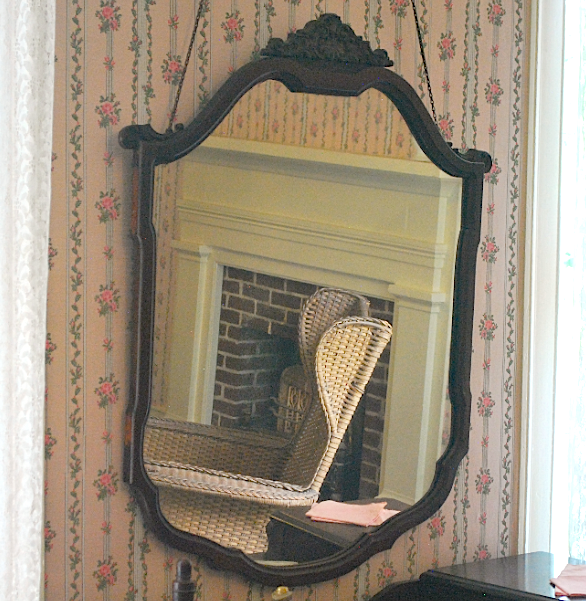 |
| Located in Oxford Mississippi, William Faulkner's home, "Rowan Oak", is hollowed ground for writers and lovers of great American literature. |
 |
| A full collection of his books sit on the shelves of his front living room. |
Museums
William Faulkner's home, "Rowan Oak".
William Faulkner 1897 - 1962
William Cuthbert Faulkner, born with the name Falkner on September 25, 1897, was an American writer and Nobel Prize laureate from Oxford, Mississippi. Faulkner worked in a variety of written media, including novels, short stories, a play, poetry, essays and screenplays. He is primarily known and acclaimed for his novels and short stories, many of which are set in the fictional Yoknapatawpha County.
 |
| Faulkner added a map of Yoknapatawpha County at the end of his novel Absalom, Absalom! |
Yoknapatawpha, pronounced "Yok'na pa TAW pha", was the original name for the actual Yocona River, a tributary of the Tallahatchie which runs through the southern part of Lafayette County Mississippi, where Faulkner spent most of his life. Also the neighboring county has a similar Indian name, Yalobusha County. Yoknapatawpha is derived from two Chickasaw words—Yocona and petopha, meaning "split land." Faulkner claimed that the compound means "water flows slow through flat land."
Faulkner is one of the most important writers in both American literature generally and Southern literature specifically. Though his work was published as early as 1919, and largely during the 1920s and 1930s, Faulkner was relatively unknown until receiving the 1949 Nobel Prize in Literature. Two of his works, A Fable (1954) and his last novel The Reivers (1962), won the Pulitzer Prize for Fiction. In 1998, the Modern Library ranked his 1929 novel The Sound and the Fury sixth on its list of the 100 best English-language novels of the 20th century; also on the list were As I Lay Dying (1930) and Light in August (1932). Absalom, Absalom! (1936) is often included on similar lists.
 |
| William Faulkner. |
 |
| The dresser in his bedroom. |
 |
| Faulkner and his wife Estelle in 1955, the year he won a Pulitzer Prize for A Fable. |
 |
| "Read, read, read. Read everything." |
 |
| Faulkner was a gentleman horseman! |
 |
| Guest bedroom. |
 |
| Faulkner wrote the outline for his Pulitzer Prize winning novel "A Fable" on the walls of his writing room. |
 |
| Faulkner would sequester himself in his writing room, to write undisturbed. |
 |
| Ancient vines on the grounds of Rowan Oak. (There are no Rowan Trees or Oak Trees on his property.) |
 |
| A chair in the guest bedroom. |
 |
| Faulkner with his dogs. |
 |
| Stately pines on the gorgeous grounds surround the unadorned-yet-elegant home. |
 |
| A beautiful bloom of the Magnolia Tree. |
 |
| Shade trees abound on the grounds of Rowan Oak. |
 |
| The front living room. |
 |
| The front living room. |
 |
| A print of Rockwell Kent's Captain Ahab from Melville's Moby Dick is on the wall in Faulkner's front living room. |
 |
| Estelle's (Faulkner's wife) painting of a magnolia flower hangs on a wall in the front living room. |
 |
| Chair in the front living room. |
 |
| A Faulkner hand lettered and illustrated book. |
 |
| The front living room. |
 |
| The foyer staircase. |
 |
| This burned window fragment was the inspiration for the character Cecelia Farmer in his Requiem for a Nun. |
 |
| Easy chair. |
 |
| "'Count No-Account' (ha) Not an act, his very graceful-poses. He was a natural"" - J.R. Cofield |
 |
| The kitchen door is shown out of a back window. |
 |
| Faulkner's dining room. |
 |
| Rowan Oak dining room. |
 |
| Faulkner's bedroom. |
 |
| Faulkner's bedroom, detail. |
 |
| Upstairs back hallway. |
 |
| Faulkner's bedroom. |
 |
| Estelle's bedroom and studio. |
 |
| Estelle's bedroom and studio. |
 |
| Rowan Oak's horse barn. |
 |
| Next to the horse barn. |
 |
| Rowan Oak grounds. |
 |
| Rowan Oak grounds. |
 |
| Rowan Oak grounds. |
 |
| The famous Square Books Bookstore on "The Square", downtown Oxford, Mississippi. |
FOOD
Pineapple/Coconut
Pecan Pie
Ingredients
2 cups sugar
1 tablespoon corn meal
1 tablespoon flour
5 eggs
pinch of salt
1 cup pecans, coarsely chopped
1 cup drained crushed pineapple
1 cup flaked coconut
1 stick butter, melted
1 unbaked pie shell
Instructions
Beat the sugar, corn meal, flour, eggs and salt together. Gently stir in the pecans, pineapple and coconut (don't beat it). Stir in the melted butter and mix well.
Bake at 300 degrees in an unbaked pie shell approximately 50 to 60 minutes.
Cover the crust edge with some aluminum foil to keep it from burning. Cook 15 to 30 more minutes, or until the pie is set.
Then sprinkled on toasted shreds of coconut.
(Source:Recipe on Facebook.)
Until later,
Jack
ARTSnFOOD, is an online publication dedicated to "The Pursuit of Happiness through the Arts and Food." ™ All rights reserved for all content. Concept, Original Art, Original Text & "Original or Assigned Photography" are © Copyright 2014 Jack A. Atkinson under all International intellectual property and copyright laws. All photographs were taken and/or used with permission. Artworks © individual artists, fabricators, respective owners or assignees.





No comments:
Post a Comment